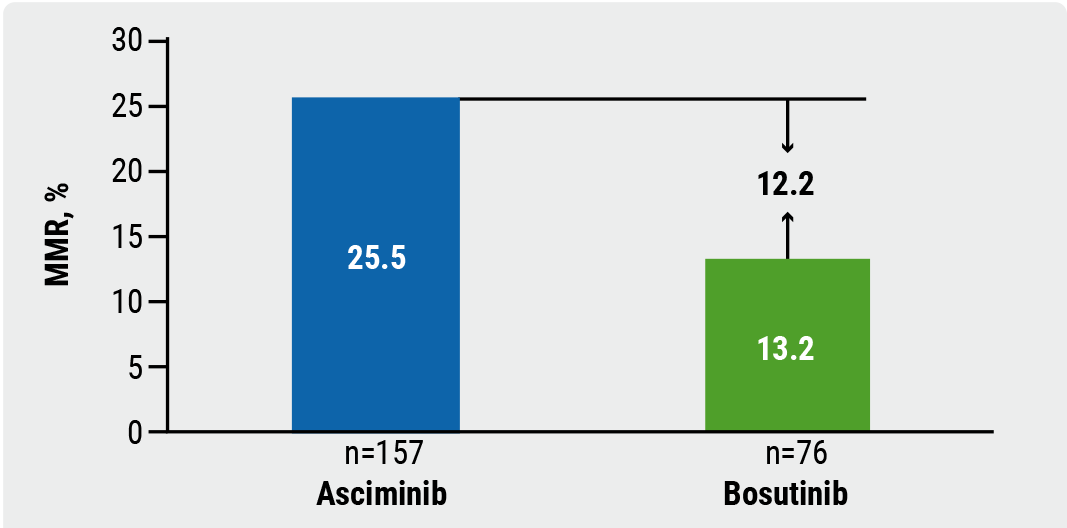Current therapies for patients with resistance or intolerance to ≥2 TKIs are limited by either modest efficacy, safety concerns, or both [2]. All currently approved TKIs bind to the ATP site of the BCR-ABL1 oncoprotein. Asciminib is a first-in-class STAMP (Specifically Targeting the ABL Myristoyl Pocket) inhibitor with a new mechanism of action [3]. In a previous phase 1 study, asciminib monotherapy showed clinical activity in heavily pretreated patients with CML. Based on this finding, the question was if asciminib could provide superior efficacy to bosutinib, a second-generation ATP-competitive TKI, beyond second line of treatment.
Dr Andreas Hochhaus (Universitätsklinikum Jena, Germany) presented results from ASCEMBL, a randomised, open-label, phase 3 study in 233 adult patients with CML-CP previously treated with ≥2 TKIs [1]. Fewer patients on asciminib discontinued their last TKI due to lack of efficacy and fewer received ≥3 prior lines of TKI therapy compared with bosutinib-treated patients.
Major molecular response (MMR) rate at 24 weeks was 25.5% with asciminib and 13.2% with bosutinib, meeting the primary objective. The between-arm common treatment difference for MMR at 24 weeks, after adjustment for major cytogenetic response status at baseline, was 12.2% (2-sided P=0.029; see Figure). Among those patients who achieved MMR, median time to MMR was 12.7 weeks with asciminib and 14.3 weeks with bosutinib.
Figure: MMR rate at 24 weeks [1]

MMR, major molecular response
At 24 weeks, a total of 61.8% of patients receiving asciminib and 30.3% of patients on bosutinib were still on treatment. The most common reason for treatment discontinuation was lack of efficacy (asciminib 21.0%; bosutinib 31.6%). Grade ≥3 adverse events (AEs) occurred in 50.6% and 60.5% of patients, respectively. Most frequent grade ≥3 AEs with asciminib were thrombocytopenia (17.3%) and neutropenia (14.7%). The proportion of patients who discontinued treatment due to AEs was lower with asciminib (5.8%) than bosutinib (21.1%).
- Hochhaus A, et al. Efficacy and Safety Results from ASCEMBL, a Multicenter, Open-Label, Phase 3 Study of Asciminib, a First-in-Class STAMP Inhibitor, vs Bosutinib (BOS) in Patients (Pts) with Chronic Myeloid Leukemia in Chronic Phase (CML-CP) Previously Treated with ≥2 Tyrosine Kinase Inhibitors (TKIs). 62nd ASH Annual Meeting, 5-8 December 2020. Abstract LBA-4.
- Hochhaus A, et al. Leukemia. 2020;34:966-84.
- Wylie AA, et al. 2017;543:733-7.
Posted on
Previous Article
« PFS and ORR benefits of first-line ibrutinib-based treatment in CLL Next Article
Addition of venetoclax provides an effective, lower-intensity regimen »
« PFS and ORR benefits of first-line ibrutinib-based treatment in CLL Next Article
Addition of venetoclax provides an effective, lower-intensity regimen »
Table of Contents: ASH 2020
Featured articles
COVID-19
More complicated course of COVID-19 in leukaemia patients
Older age and imatinib treatment associated with COVID-19 mortality in CML
Allogeneic SARS-CoV-2-specific T cells to treat COVID-19
More severe COVID-19 outcomes for patients with haematologic malignancies
Acute Lymphoblastic Leukaemia
Improved outcomes, but still substantial part experiences relapses
Strong correlation between peripheral blood and bone marrow NGS MRD
Encouraging outcomes after autoHCT in patients with ALL
Acute Myeloid Leukaemia
Prognostic validity of AML composite model in predicting mortality
Venetoclax plus hypomethylating agents in favourable-risk AML
Encouraging clinical activity of decitabine plus ipilimumab in R/R or secondary MDS/AML
AML patients with specific mutations are unlikely to achieve MRD
Comparable outcomes with gilteritinib or quizartinib in R/R AML
First-in-class macrophage immune checkpoint inhibitor in AML
Bispecific DART® as salvage therapy for primary induction failure and early relapse
Gilteritinib in R/R AML patients priorly treated with midostaurin or sorafenib
Addition of venetoclax provides an effective, lower-intensity regimen
Chronic Leukaemia
Bosutinib effective and well tolerated in newly diagnosed CP-CML
Efficacy and safety of ponatinib in patients with CP-CML who failed second-generation TKIs
First-in-class STAMP inhibitor versus bosutinib in resistant or intolerant CML
PFS and ORR benefits of first-line ibrutinib-based treatment in CLL
Multiple Myeloma
Validation of MY-RADS response assessment category criteria
High symptom burden in transplant-ineligible patients with newly diagnosed MM
Added value of ixazomib to lenalidomide plus dexamethasone in transplant-ineligible newly diagnosed MM
Survival of transplant-eligible newly diagnosed MM in FORTE trial
Better survival with upfront autoSCT versus bortezomib-based intensification
Subcutaneous daratumumab plus pomalidomide and dexamethasone in R/R MM
Melflufen well tolerated with encouraging activity in heavily pretreated R/R MM
Initial data of FcRH5/CD3 T-cell-engaging bispecific antibody
Lymphoma
CD58 aberrations limit durable responses to CD19 CAR T-cell therapy
Anti-CD19 CAR T-cell therapy in relapsed/refractory indolent NHL
Myeloproliferative Neoplasms
MPN disease burden, quality of life, and treatment patterns
Interventions in JAK/STAT signalling pathway
Novel, orally available inhibitor of BCL-XL/BCL-2
New insights into genetics of MPN
Immune Thrombocytopenia
Mycophenolate efficacious and tolerable, even in elderly patients
First-in-class antibody sutimlimab selectively inhibits classical complement pathway
BTK inhibition provides clinically active and durable platelet response
Haemophilia, Sickle Cell Disease, Thalassaemia
First results from gene therapy trial in haemophilia B
Impact of haemophilia on children and their caregivers
Promising CRISPR gene editing results in β-thalassaemia and sickle cell disease
Erythroid maturation agent in patients with β-thalassaemia requiring regular RBC transfusions
Related Articles
February 18, 2021
Impact of haemophilia on children and their caregivers
February 18, 2021
First results from gene therapy trial in haemophilia B
© 2024 Medicom Medical Publishers. All rights reserved. Terms and Conditions | Privacy Policy

